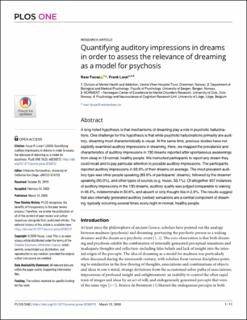| dc.contributor.author | Fosse, Roar | |
| dc.contributor.author | Larøi, Frank | |
| dc.date.accessioned | 2021-05-05T13:28:58Z | |
| dc.date.available | 2021-05-05T13:28:58Z | |
| dc.date.created | 2020-07-03T13:31:18Z | |
| dc.date.issued | 2020 | |
| dc.Published | PLOS ONE. 2020, 15 (3), . | |
| dc.identifier.issn | 1932-6203 | |
| dc.identifier.uri | https://hdl.handle.net/11250/2753741 | |
| dc.description.abstract | A long noted hypothesis is that mechanisms of dreaming play a role in psychotic hallucinations. One challenge for this hypothesis is that while psychotic hallucinations primarily are auditory, dreaming most characteristically is visual. At the same time, previous studies have not explicitly examined auditory impressions in dreaming. Here, we mapped the prevalence and characteristics of auditory impressions in 130 dreams reported after spontaneous awakenings from sleep in 13 normal, healthy people. We instructed participants to report any dream they could recall and to pay particular attention to possible auditory impressions. The participants reported auditory impressions in 93.9% of their dreams on average. The most prevalent auditory type was other people speaking (83.9% of participants’ dreams), followed by the dreamer speaking (60.0%), and other types of sounds (e.g. music, 33.1%). Of altogether 407 instances of auditory impressions in the 130 dreams, auditory quality was judged comparable to waking in 46.4%, indeterminate in 50.6%, and absent or only thought-like in 2.9%. The results suggest that also internally generated auditory (verbal) sensations are a central component of dreaming, typically occurring several times every night in normal, healthy people. | en_US |
| dc.language.iso | eng | en_US |
| dc.publisher | PLOS | en_US |
| dc.rights | Navngivelse 4.0 Internasjonal | * |
| dc.rights.uri | http://creativecommons.org/licenses/by/4.0/deed.no | * |
| dc.title | Quantifying auditory impressions in dreams in order to assess the relevance of dreaming as a model for psychosis | en_US |
| dc.type | Journal article | en_US |
| dc.type | Peer reviewed | en_US |
| dc.description.version | publishedVersion | en_US |
| dc.rights.holder | Copyright 2020 The Authors | en_US |
| dc.source.articlenumber | e0230212 | en_US |
| cristin.ispublished | true | |
| cristin.fulltext | original | |
| cristin.qualitycode | 1 | |
| dc.identifier.doi | 10.1371/journal.pone.0230212 | |
| dc.identifier.cristin | 1818456 | |
| dc.source.journal | PLOS ONE | en_US |
| dc.source.40 | 15 | |
| dc.source.14 | 3 | |
| dc.identifier.citation | PLOS ONE. 2020, 15(3): e0230212 | en_US |
| dc.source.volume | 15 | en_US |
| dc.source.issue | 3 | en_US |

